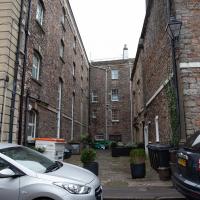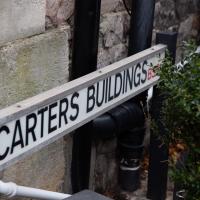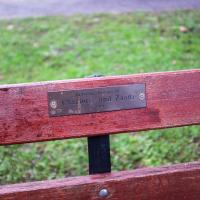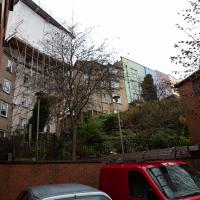Tagged: plant
And Back Down the Hill from the Flu Jab
21 Nov 2020
This is my return from getting my annual flu jab at Christ Church, as explained in more detail in my wander up the hill.
I don't think this is exactly a public right of way. But I started so I tried to finish without getting the police called on me by worried residents
I do love this terrace. The mansard roofs, the grand central house, the ornamentation, the porches. It's all rather grand.
Don't know what the JMJ is all about. Seems to be part of Cedar Care Homes (this is all behind their grand head office on Clifton Down Road, Mortimer House), but it's hard to tell for sure.
Ironically, this is the second photo I took as the first one wasn't in focus. Not sure how I managed that. Anyway. I like Focus on the Past and could browse in there for ages. When they're open they usually have an array of furniture and other goods out on the front apron, too.
For some reason I'm reminded of the time I was browsing the sadly-now-gone Avon Books (which used to occupy 4a Waterloo Street, next to Kitchen Artillery, which occupies 4b) and found that all the books on subjects like this were collected into a section labelled "Mumbo Jumbo"
Up for the flu jab
21 Nov 2020
A trip up the hill to get my winter flu jab. I'm not sure I really needed it this year, what with avoiding Covid—I haven't had so much as a sniffle in more than a year—but seeing as they offered... Instead of the doctor's surgery on Pembroke Road, they'd taken over Christ Church, presumably to give more room and ventilation for the necessary social distancing at the moment. As usual, it was their typically efficient operation, and I was in and out in about three minutes.
On the way there and back I snapped as much as I could, but I wanted to be home in time for the first online Times Crossword Championship. As it turned out, I needn't have bothered, as the technology at the Times couldn't keep up with the demand from competitors, and their system just collapsed under the weight of page-views. They tried again the day after, and it collapsed just as badly. Maybe next year...
This wander is split into two parts, as I turned my tech off to go into Christ Church for my jab. The walk home can be found over here.
This was meant to be the day of the first online Times Cryptic Crossword Championship. Sadly the Times's web servers let them down, so the event was a washout, and I dashed back from my flu jab to take part for no good reason, as it turned out.
Although it looks like the side of the kind of flats you see everywhere in Clifton Village, the building to the left is actually the Christchurch Recording Studios. Among other artists who've used the studios, two of Massive Attack's number one albums were recorded here, according to this article that sadly but inevitably seems to suggest that the building might be converted into luxury flats soon.
It was originally fitted out as a drama and recording studio by the BBC in the 1980s.
The destination for my wander today. My doctor's surgery branched out into Christ Church to give them more room for socially-distanced administering of the flu jab. Fast and efficient as usual.
Avoiding the Accounts
26 Nov 2020
I took the day off my day job to do my accounts—or at least do enough bookkeeping to send them to my accountant. I hate doing the books. I woke up late, tired and with a headache and decided to bunk off for a walk around Cliftonwood, Clifton Village and Clifton instead, taking in a couple of good coffees along the way. Thanks, Foliage Café, and Twelve for the flat whites.
The Hillsborough Flats are a lot prettier from the back than their frontage on the Hotwell Road suggests, I think.
The Long Lunchtime at the End of the World
27 Nov 2020
I took an extra-long break at lunchtime today as I'd taken the day off my normal day-job to do the accounts for my previous side-job, which is still generating paperwork, though not much in the way of money. This took me through some undiscovered bits of Cliftonwood, including Worlds End Lane, which unexpectedly leads to White Hart Steps. That's certainly not where I expected the end of the world to lead to...
I came up here drunk one night, searching for a shortcut home from somewhere around the Triangle. At least this time I was reasonably sure I'd not get out of the far end here.
You'll have trouble getting the bus up the White Hart steps.
Edit to add: According to my friend Jess (a very reliable source of information about Cliftonwood who's quoted in this Bristol Post article about the bus stop) it was put in 15 years ago as part of the West Bristol Arts Trail...
A long ramble, starting with trying to find the Hot Well of Hotwells and leading up the side of the Avon Gorge to the Downs and then through Clifton for coffee.
Vik and I often just stand back calling helpful advice like "please don't die!" when Sarah's off getting a picture from some liminal space or other.
Ten O'Clock Shop and Can't Dance Coffee
30 Nov 2020
I had to return a faulty AirPod Pro to Apple (there's a first-world problem!) so I just took a quick trip up the hill to the nearest UPS drop-off point, The Ten O'Clock Shop, which is famously open until 11pm. Unfortunately it's a fairly cramped little place and neither of the staff were wearing masks, so I made it a very quick drop indeed and got out of there as quickly as I could.
I grabbed a quick coffee from Can't Dance, a stall that's—as of yesterday—in a tiny converted cargo container on the edge of Victoria Square; up until this week they were running from a little trike parked in the same place. Hopefully the new premises will let them see out the winter without worrying quite so much about the weather.
I tried to fit in a few extra streets from the surrounding area on my there and back, but that was basically my wander today: a quick little shopping trip.
This bit of grass is apparently called "Bobby's Green" or "Bobbies Green"—I've seen it written both ways. Several locals call it this; the only guess I've seen came from Louise on NextDoor:
don’t know why it’s called the Bobbies green except sometimes policemen used to lean or leave their bikes on the railings before there were so many parked cars. They used to come up constitution hill from the old police station at the entrance to Brandon hill on Jacobs Wells Rd and cycle around clifton so maybe that’s the reason- but that’s just a random guess.
Mint on the left, Rosemarino on the corner ahead, where the old York Cafe used to be, serving a full English for £1, back in the day.
Looking down onto Hanover Lane, which I often use as a cut-through when heading for the Triangle. In the Beforetimes I'd often walk between Waitrose and home via that route.
Around the back of the White Rabbit, which was the Richmond Spring when I first moved to the area, I think.
I'm not a great fan of their coffee, but that was based on a single try, so I should probably give them another go at some point. But there's so much coffee nearby that's pretty much guaranteed to be excellent—Twelve, Foliage, Spicer+Cole, to name but three—it's hard to take a chance.
Fruitless Coffee Excursion
01 Dec 2020
Unfortunately by the time I got to Greville Smyth Park I was already about halfway through my lunch-hour, and the queue was too long to wait to actually get a coffee. Is that a fruitless excursion? Presumably a coffee bean is technically a fruit...
This kind of vague musing was sadly overshadowed by my delay at Ashton Avenue Bridge on the way back, where someone—hopefully still a someone, rather than a body—was being stretchered up the bank of the river, presumably having just been rescued from the water. As I made my way home the long way around, avoiding the cordoned-off area at the back of the CREATE centre and its car park, I saw an ambulance haring across the Plimsoll Bridge, siren running, presumably on its way to the BRI. I'd like to think that was a good sign.
Nothing New
02 Dec 2020
This may be the very first time I've gone for a One Mile Matt wander and not actually gone down any new roads, trod any new steps. I just wanted a coffee, frankly, so I went the same old way to Imagine That in the marina and back again.
I think someone lost their hair extension. Or this is the resting place of a My Little Pony that's been buried arse-up.
As I understand it, these are the numbers assigned to the people (who am I kidding? men.) who lived in the dockers' houses on Avon Crescent; the houses still have their separate numbers.
An office for one of the industrial places along Coronation Road; I think this is the back of the metal spraying yard rather than the tannery.
I shot this on a film camera when I lived at Baltic Wharf during the mid-nineties. Interesting to compare with the present day, I think. "Hand of the River God" by Vincent Woropay has lost its figure of Hercules carrying an obelisk in the meantime.
Cliftonwood and a Secret Garden
03 Dec 2020
I love the isolation of Cliftonwood -- the geography of it, with its solid boundary of Clifton Vale to the west and Jacob's Wells Road to the east mean that you tend not to be in Cliftonwood unless you've got a reason to be there. It's not a cut-through to anywhere, at least not from side-to-side, and you can only really exit to the south on foot.
I sense that I'd be happy living in Cliftonwood -- like my bit of Hotwells, it's a quiet little area with a sort of quirky feel to it. Plus it contributes the colourful houses that are the backdrop of about half of all Bristol postcards ever made :)
I found the "secret" garden especially interesting, just for the fact that it really does feel quite secret, despite the obvious name on the gate. I've lived a half-mile from it for twenty years and I don't think I've ever noticed it before, despite exploring the area a few times.
From the Independent obit, March 1999:
PETER WARE was one of the West Country's most eminent architects. He was a leading member of the generation of conservationists who acted in time to save the region's historic building stock in the Sixties and Seventies, and a versatile designer too of modern edifices.
...
Among his less prominent jobs was the transformation of the threatened 18th-century Hope Chapel in Hotwells into a flourishing community centre. One of its most successful activities became an annual pantomime. Ware, in Edwardian bathing costume or silly hat, dancing the tango with a dummy or being fired from a mock cannon, was a staple of the cast. He greatly enjoyed a bit of clowning and a good laugh.
Until he and his wife Marie moved out of Hotwells in 1996, to be nearer to their horses and woodland, Ware remained a faithful participant in the minutiae of neighbourhood affairs, chairing the Dowry Square Garden Committee, and was always on hand with technical advice on houses, keenly interested in local planning matters.
Something about this seems Greek, possibly because a Greek capital Rho looks like an English "P".
I did once have a beer in the garden when it was The Spring Gardens. It became La Demi Lune for a while, from what I remember, then shut down. Having just Googled it, before it was the Spring Gardens apparently it was "Durty Nelly's"!
From what I can see on Street View it's just flats now, but I can't be sure without going and having a proper look around the front. Maybe next time...
I got curious about Bioinduction's sign down on the Hotwell Road once. According to the company's website theire mission is to "develop a precisely targetted brain pacemaker that offers new hope for the millions of sufferers... To revolutionise the treatment of cerebrovascular and neurodegenerative diseases where there is no effective drug therapy available today."
Apparently Gnodal "was a computer networking company headquartered in Bristol, UK. The company designed and sold network switches for datacenter, high-performance computing and high-frequency trading environments"
Strangers' Burial Ground
04 Dec 2020
I tried to find the Strangers' Burial Ground the last time was up in Clifton, but I'd not realised that Lower Clifton Hill continues further on after the turning with Constitution Hill. Sadly it was chained shut, but it still looks beautifully-maintained, perhaps by the same man referenced by this story from John Hodgson, which helped me find it. Apparently Thomas Beddoes is buried here.
Although, given the sign, perhaps I shouldn't have. But I didn't think they'd object terribly. I've actively interested in living here; a couple of flats have popped up on the market in recent times and the views are amazing.

































































































